Corsair RM1000 Power Supply Review
by E. Fylladitakis on April 24, 2014 6:00 AM EST- Posted in
- Cases/Cooling/PSUs
- Corsair
- PSUs
- RM Series
Hot Test Results
From the tables below, it can be seen that the output power quality of the Corsair RM1000 is very good. The maximum voltage ripple that our instrumentation recorded was just above half of the ATX design guide suggested limit (the limits are 120 mV on the 12V line, 50 mV on the minor voltage lines), under full load and inside the hotbox. Cross-load testing negatively affects the power quality of any power supply, yet the RM1000 manages to pass the test, with the 12V line registering up to 98 mV while delivering a massive 800W.
| Main Output | ||||||||
| 203.84 W | 506.25 W | 752.95 W | 997.56 W | |||||
| 20.38% | 50.62% | 75.29% | 99.76% | |||||
| Line | Amperes | Volts | Amperes | Volts | Amperes | Volts | Amperes | Volts |
| 3.3 V | 4.14 | 3.40 | 10.36 | 3.37 | 15.53 | 3.34 | 20.71 | 3.30 |
| 5 V | 4.14 | 5.14 | 10.36 | 5.11 | 15.53 | 5.00 | 20.71 | 4.98 |
| 12 V | 13.80 | 12.21 | 34.50 | 12.13 | 51.76 | 12.04 | 69.01 | 11.97 |
| Line |
Regulation (20% to 100% load) |
Voltage Ripple (mV) | |||||
| 20% Load | 50% Load | 75% Load | 100% Load | CL1 12 V | CL2 3.3 V + 5 V | ||
| 3.3 V | 3.0% | 16 | 24 | 26 | 30 | 10 | 26 |
| 5 V | 3.1% | 18 | 26 | 30 | 36 | 12 | 30 |
| 12 V | 1.95% | 26 | 30 | 54 | 70 | 98 | 24 |
The impact that the higher ambient temperature has on the energy conversion efficiency is virtually miniscule, reducing the average nominal load (20-100%) efficiency of the RM1000 from 91.8% down to 91.4%. This is an excellent result for such a powerful power supply, especially when the ambient air temperature increased by more than 20 °C.
The large increase in the ambient air temperature naturally has an effect on all of the temperature readings. This time the fan starts a bit earlier, at 40% load, and its speed increases rapidly, obviously reacting to the high heat. The speed of the fan virtually maxes out at 70% load, with the cooling system giving everything it has to keep the RM1000 cool enough. The fan becomes clearly audible but not overly loud even while the unit is severely stressed, but its speed cannot be increased any further and so it is unable to help the thermal performance of the RM1000 beyond a certain point.
While the power supply keeps operating just fine, the temperatures are significantly elevated, above what we consider a "comfortable limit". This however also is with an ambient temperature significantly higher than the 40 °C rating of this power supply, therefore the fact that it can keep delivering its maximum output and electrically perform well enough to maintain its specifications is quite a feat.


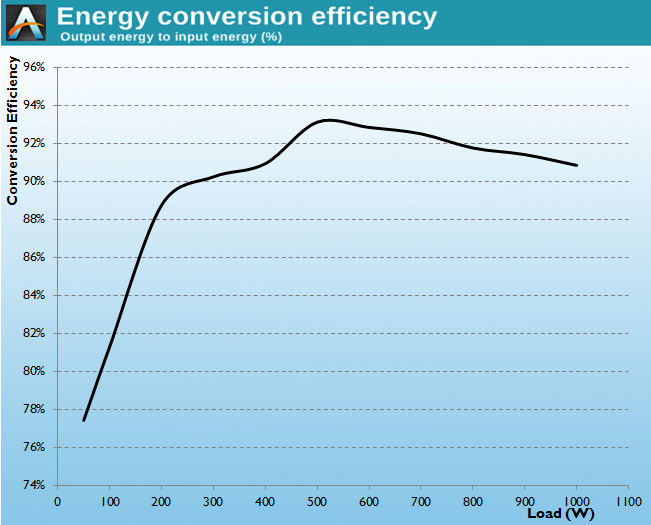
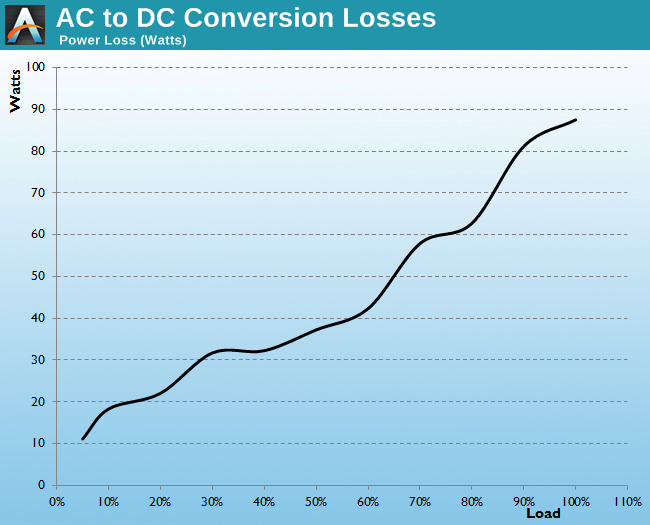
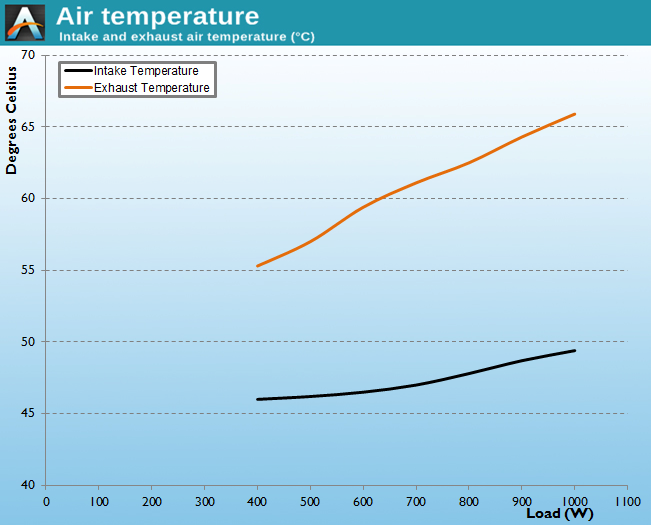
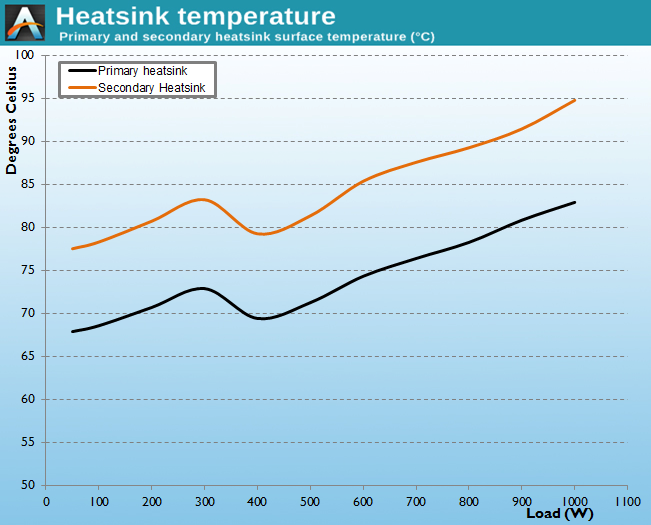
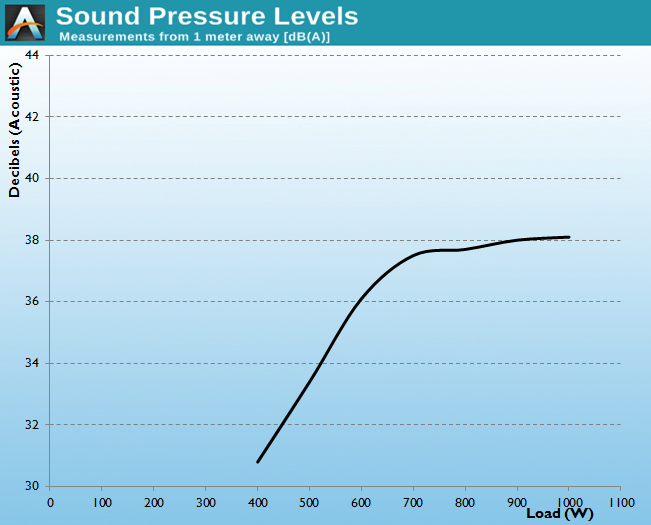








55 Comments
View All Comments
khanov - Saturday, April 26, 2014 - link
You can turn off the fanless mode on Seasonic's PSUs. That'd be a good option for Corsair to adopt I think.As for the Teapo comment, surely you cannot be serious. Teapo electrolytics as filters are a terrible option. They rarely last even half their rated lifetime. I replace Teapos quite a lot in consumer electronics devices (TVs, set top boxes, DVRs etc). They seem to go about 5 years on average before they fail with open vents.
The real problem when you go lower than first tier Japanese is that the manufacturers will sometimes straight up lie on their spec sheets. So they look like they should perform just as well on paper, but they never meet that performance in real applications unless treated much more gently than their specs would suggest. Ripple current (real vs rated) is one area where I see a lot of this happening and Teapo is one of the culprits.
YoloPascual - Friday, April 25, 2014 - link
I know your work for Corsair now jonny. Don't worry many ppl will still buy your incompetent psu because most of the people knows that if a psu has corsair sticker, it must be excellent.And no japanese caps are not over-rated actually they are under-rated. I got a Delta made psu from 1999 running like champ. It has a combination of Rubycons and Nippon-Chemicon.
royalcrown - Monday, April 28, 2014 - link
Come on! You act like Corsair sells dog poop. Whether or not you like them, they are not junk either. Calling it incompetent just reeks epeen elitism...just4U - Saturday, April 26, 2014 - link
What I really dislike about the RM line is they are very close in price to the HX series that was made by seasonic. (A company I trust) I expected these to be made by them.. but nope. Ticks me off.. I like Corsair branded Seasonics.. their the only ones I will buy, period. If Corsair is moving away from them.. then I am moving away from Corsair.Harald - Monday, May 5, 2014 - link
Actually, there was only ever one HX model made by Seasonic and that was the first revision of the HX650. I have the HX750 which is made by CWT, it's going on 4 and half years old and working like a charm.Harald - Monday, May 5, 2014 - link
(Sorry, forgot about the HX520 and 620)khanov - Friday, April 25, 2014 - link
+1 from me too.I'd have to skip this and go straight for an all Japanese-capped unit.
Also, are you sure there aren't any Ltec caps int here? I can't see well enough, but those green filters on the secondary side look suspiciously like the worst caps money can buy.
sor - Friday, April 25, 2014 - link
I didn't see the voltage being tested. usually there's a 2-3% efficiency gain at 220-240VJASTECH - Friday, April 25, 2014 - link
I have a 1050w modular, don't recall brand, I bought before my surgery then ressesitated, ICU then on O2 24/7. So its been a few years sense my purchase, anyways, out of the box hooked up not working. Tested it, seems a 5vdc not working. Quality PSU is DOA, so QC is still lacking.meacupla - Saturday, April 26, 2014 - link
YES to ribbon cables. More PSUs should come with this, as it is superior to braided sleeving and individual strands in terms of routing and bundling.NO to right angle SATA connectors! The cable lengths end up being wrong anyways and there is extreme strain on the cable where the pins bite into the wire. The cable just doesn't bend as smoothly as daisy-chained straight connectors.